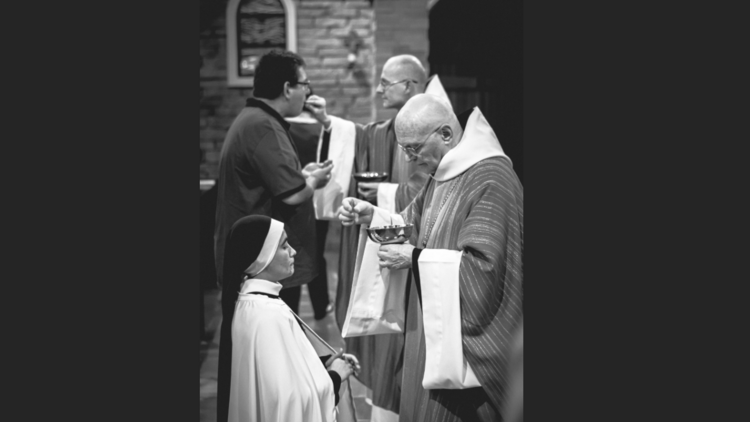The parishioners are inching along the center aisle. A rosy-cheeked toddler babbles in the arms of her mother. Against the cold, granite floors, the metallic click of a silver cane guides a graying man forward. The choir proclaims: “Take and eat the goodness of the Lord.”
The gentleman in front of me moves slowly down to his right knee. It is not a graceful movement, but he carries himself with reverence and dutifully makes the Sign of the Cross. Next, a woman bows forward, and her long ponytail flips over her shoulder. Her face is parallel to the floor. She stands upright again, proudly announces “Amen” and opens her mouth to receive the host on her tongue.
Now, it is my turn. Should I outstretch my hands as my second-grade Communion classes taught me, and as I’ve done every Sunday? The diversity of these postures that preceded me has me wondering: What is the best way to receive the Eucharist?
While church documents do not dictate a single way to receive Communion, we can trace the discussion of these postures back to the earliest days of Christianity.
A Catholic’s preferred posture for receiving Communion has long been a matter of discussion, one that has been revisited and revised over centuries. Within each parish community, one also can observe various postures used by communicants. In my experience, most people choose a method of receiving—either in your hands or on your tongue—and a posture while receiving—either standing or kneeling before the priest or eucharistic minister. This list is not exhaustive, particularly considering the diversity of the universal church. While church documents do not dictate a single way to receive Communion, we can trace the discussion of these postures back to the earliest days of Christianity.
Receiving Communion in your hands
“Receiving the Eucharist in the hand was the common practice of the church both in the East and West for the first 800 years of Christianity,” said Paul Janowiak, S.J., an associate professor of liturgical and sacramental theology at Santa Clara University. “There was, to my knowledge, no question of it being irreverent and was certainly lauded as a practice of solemnity and devotion by many of the Church Fathers.”
These Church Fathers expressed a need for the “communicant to feel awe” while receiving. Fourth-century figures such as Cyril of Jerusalem wrote approvingly of receiving the host in the hands: “Coming up to receive [...] making your left hand a throne for the right (for it is about to receive a King).”
Our hands are the direct means by which we hold the body of Christ and connect to the celebration of the Eucharist, whether or not those hands are ordained.
John Chrysostom, another early father of the church, in 347 A.D. stated that human beings, made in the image and likeness of God, are more worthy of receiving Communion in their hands than a metal cup or bowl “because those vessels are made so for our sakes. They partake not of Him that is in them, they perceive Him not. But we do—yes, verily.” Our hands are the direct means by which we hold the body of Christ and connect to the celebration of the Eucharist, whether or not those hands are ordained. “I would say priests are not more worthy or holy to receive in the hand than all the members of the People of God,” said Father Janowiak.
Receiving the host in the hand and the precious blood from a chalice was affirmed after the Second Vatican Council as an acceptable and reverent way to receive the Eucharist. “Sharing Communion as one body, with the affirmation of the communicants’ belief by opening one’s hands reverently and saying “Amen” (“So be it”), was the truest meaning and identity of the sacramental body of Christ and the Church herself” following Vatican II, said Father Janowiak.
In today’s church in the United States, receiving the host by hand and drinking from the chalice is “the most common way to receive for both clergy and lay” communicants, said Father Janowiak.
Receiving on your tongue
While in many places the church continued to offer Communion in the hand, beginning in the early Middle Ages, receiving the Eucharist on the tongue grew in popularity within the Latin Rite.
While it is unclear when the practice officially emerged, changing ideas about the Eucharist and its liturgical significance prompted mandates from local councils in an attempt to ensure uniformity and reverence while receiving. For instance, the reception of the host on the communicant’s tongue was mandated by a local council in Rouen, France, in 878, as it was believed by the bishops of Rouen that only the consecrated fingers of a priest should touch the host. A council document stated, “Let not the Eucharist be put in the hand of any layman or woman, but only in the mouth.” Although in this case, Rouen was a provincial council (it would be up to Rome to decide official mandates for the universal church), several communities around the world adopted similar mandates for fear of desecrating the Eucharist by placing it in lay people’s hands.
Beginning in the eighth century in the Eastern rite churches, in concordance with Rome, the bread was consecrated and soaked in the precious blood. The saturated fragments of consecrated bread were distributed directly into the mouth with a Communion spoon. In the medieval West, infants were the only members of church communities to receive the precious body and blood, as it was believed that because of their innocence, infants were the most worthy of receiving. The priest would draw the precious blood into a metal straw called a fistula, sometimes creating an intinction by mixing the crumbs of the host with the wine and then placing droplets into the mouth of the infant.
Receiving Communion by means of a special spoon or straw, methods that originated in the early Eastern rite and medieval West and are still used today by churches in the Eastern Orthodox tradition, are natural developments from a concern of the early church: preventing spillage of the body and blood when distributing them to infants. The spoon and straw are sometimes viewed as archaic methods by communicants despite emerging after the older and more popular methods of receiving the Eucharist, but they still achieve their purpose: reverence in the celebration of the Eucharist.
Kneeling in front of the Eucharistic minister
“Gestures in the liturgy are meant to express the communion we share with Christ and one another,” said Father Janowiak. Often communicants who kneel before the eucharistic minister view the lowering of oneself before the body of Christ as a special way to show reverence and respect. To kneel is to acknowledge a humility within oneself physically and an openness to rise again, after receiving, renewed in the strength in the power of God. Some parishes continue the use of the altar rail as a space to kneel comfortably to receive Communion.
Does the difference in our postures matter?
Today, individual bishops can permit multiple acceptable, reverential ways to receive Communion. Yet it remains up to the communicant to decide how they will receive it.
The diversity of postures shows “our unity, which is not uniformity,” said Kimberly Belcher, an associate professor of liturgical studies at the University of Notre Dame. “It’s a little awkward and bumpy, but it’s beautiful,” she said. When we see people receiving the Eucharist in different ways, “what that highlights for us is the beauty of diversity.” The position your body assumes needs to be what feels most natural and reverent to you, as it is both a personal and communal experience of God, said Professor Belcher.
The position your body assumes needs to be what feels most natural and reverent to you, as it is both a personal and communal experience of God, said Professor Belcher.
When we try to assume a posture that is inauthentic to who we are, “we lose the true meaning of what we are there to do and be,” said Father Janowiak. But using that moment to try to make a statement “is not one of the ways to receive such a precious gift and calling,” he added.
Professor Belcher added that we also should try to avoid a preoccupation with what others are doing:
I think what unifies us in the Eucharist is not a posture but is the agape love for the other people that are in that [Communion] line, that are with us, and for the other people throughout the world that are parts of Christ that aren’t there with us. The one thing that’s really out of sync with receiving Communion is judging our brothers and sisters for how we receive Communion.
Agapic love in the Communion procession.
Professor Belcher also offered a reminder that the Communion line is different from other forms of queuing. “It’s really easy to think of [the Communion line] as the line before you board the aircraft where you’re waiting, or in the checkout line at the grocery store,” she said.
She also noted that the various postures we assume during Mass have held various meanings over time. “The Early Church thought of standing during the Eucharist as taking on the posture of the risen Lord, who had been laid down in the grave.”
There is no “best” or “perfect” posture for receiving Communion, so long as, at the heart of it, expresses our desire to join in communion with Christ.
In the way of the early church, we, as communicants, must not only be focused on the way we present ourselves before the eucharistic minister, keeling or with our hands outstretched, but also the way we approach the Communion procession itself, Professor Belcher said. “I think we must remember that standing is a sign of our hope of sharing in the resurrection of Christ. When we go forward for Communion we’re not just standing in line. We’re in a procession where the people of God are nourished by the Father.”
This reflection on the ways we receive Communion reminds us of the fact that the idea of reverence is complicated and involves various postures of the body; but more important, it involves, as Professor Elizabeth Klein names it, “the attitude of the heart.” Regardless of the postures by which we receive the precious body and blood, we as the church carry within us a reverence that grows inwardly, as we partake humbly in the mystery of Christ.
How we partake in that mystery, kneeling, receiving the host in our hands, or on our tongue, is secondary to the experience of humility and honor in receiving the Eucharist. It would benefit us to remember that, while our reverence during Mass is important, we are also called to live “the kind of life that receiving the Eucharist commits us to,” said Professor Belcher. We receive Communion on our hands that will serve others, on our tongues that will speak the good word. We kneel as a sign of our humility before God, a humility that hopefully extends to our daily lives. There is no “best” or “perfect” posture for receiving Communion, so long as, at the heart of it, expresses our desire to join in communion with Christ.








